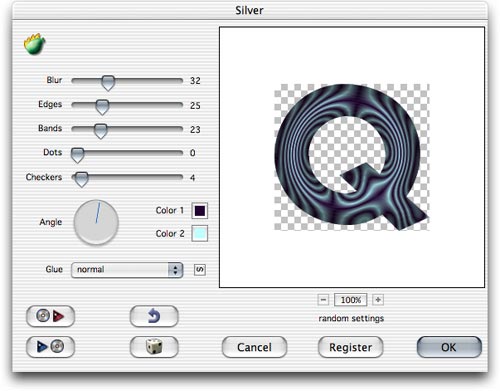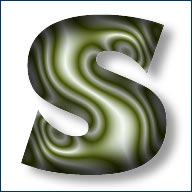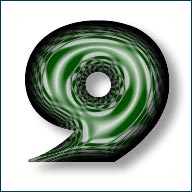|
What it does
How to install
Controls
Things to try
Versions
How to Purchase
Questions
|
 |
Silver
What it does
Silver makes image selections glitter with polished brightwork. Stylish stripes, checkers, and dots describe the shape of the surface.
How to install
Illustrated installation instructions are online.
To use this software, you need a paint program which accepts standard
Photoshop 3.0 plugins.
Just put the plug-in filter into the folder where your paint program
expects to find it. If you have Photoshop, the folder is Photoshop:Plugins:Filters or Photoshop:Plug-ins. You must restart
Photoshop before it will notice the new plug-in. It will appear
in the menus as Filters->Flaming Pear->Silver.
Most other paint programs follow a similar scheme.
If you have Paint Shop Pro: you have to create a new folder, put the plug-in filter into it, and then tell PSP to look there.
PSP 7:
Choose the menu File-> Preferences-> File Locations... and choose the Plug-in Filters tab. Use one of the "Browse" buttons to choose the folder that contains the plug-in.
The plugin is now installed. To use it, open any image and select an area. From the menus, choose Effects->Plug-in Filters->Flaming Pear->Silver.
PSP 8, 9, and X:
Choose the menu File-> Preferences-> File Locations... In the dialog box that appears, choose Plug-ins from the list. Click "Add." If you are using PSP 8 or 9, click "Browse". Now choose the folder that contains the plug-in.
The plugin is now installed. To use it, open any image and select an area. From the menus, choose Effects->Plugins->Flaming Pear->Silver.
Controls
When you invoke Silver, a dialog box will appear:

Quick start
|
|
|
|
| If you just want to see some effects quickly, click the dice button
until you see something you like; then click OK.
Using the dice is the easiest way to use Silver. If you want to hand-tune your own effects, it helps to learn the controls, which are explained below. |
|

dice |
|
Settings
|
|
|
|
|
Silver's controls let you change the form and color of the patterns that get drawn into your image selection.
Blur controls the width of the zone around the edge of your selection where Silver draws its effects. Most of the time, you'll want a blur large enough to cover the whole selection.
Edges darkens down the edge to provide a more 3D look.
Bands sets the number of color stripes drawn. The bands follow the curvature of the edge.
Dots introduces small bright dots into the pattern of bands.
Checkers draws further stripes at right angles to the other stripes.
Angle spins the whole arrangement of bands, dots, and checkers.
Two color buttons set the color range for the pattern.
|
|

color button
|
|
Things to try
|
|
|
|
|
Try loading the settings files that come with Silver to see what it can do, or click the dice until you see something you like.
Here are some example effects that you can do. Open a favorite picture for these examples, select part of the picture using lasso or text tools, and invoke Silver.
|
|
|
|
|
|
|
|
| 1. Metallic glitter.
Use these settings:
Blur 15
Edges 40
Bands 15
Dots 0
Checkers 100
Use navy and pastel blue for the two colors.
Changing the Bands control will vary the amount of detail in the glitter.
The Dots and Checkers controls will change the exact look of the glitter.
|
|
 |
|
|
|
|
|
| 2. Stripes.
Use the same settings as for the first example, but increase Blur to about 30 and set checkers to zero. Change the colors too if you want.
With no Dots or Checkers, the bands are clearly visible.
|
|
 |
|
|
|
|
|
| 3. Zoomy patterns.
To get this effect, you need three main ingredients:
-A large Blur.
-A small Edges setting.
-A thick, husky selection shape.
|
|
 |
|
|
|
|
|
| 4. Details.
To produce a result with tiny details like this, set Bands very high and experiment with the Dots and Checkers to produce an effect you like.
The dark rim comes from using a high Edges setting.
|
|
 |
|
|
|
|
|
| 5. 3-D plaid.
This effect is like Details, but with a medium Bands setting and less Edges.
Trying very low or very high Bands settings can produce some of the best results.
This effect is in a file called "greenplaid" that comes with Silver.
|
|
 |
|
Other controls
|
|
|
|
| Dice The dice choose a random effect. Click as much as you want to
see different effects.
Glue mode popup menu Lets you combine the result with the underlying image in various ways. Modes other than "normal" produce special effects. The next-glue button advances to the next glue mode.
Plus, % and minus buttons: These zoom the preview in and out. Drag the preview
to move it.
Load preset Silver comes with some presets, which are files containing settings. To load one, click this button and browse for a preset file.
Save preset When you make an effect you like, click this button to save the
settings in a file.
Undo backs up one step.
OK Applies the effect to your image.
Cancel Dismisses the filter, and leaves the image unchanged. |
|

dice

next glue

load preset

save preset

undo
|
|
|
Versions
Version 1.55 June 2007
Fixes a problem where the plug-in wouldn't remember its registration when it was installed in one user account but activated in another.
Version 1.4 July 2004
Works in 16-bit color.
Version 1.3 December 2003
Recordable as a Photoshop action.
Version 1.25 September 2003
Adds more glue modes and the next-glue button.
Version 1.22 February 2003
Adds more glue modes and fixes a crash that could happen when using the menus under Windows XP.
Version 1.21 December 2002
Adds new glue modes: Color, Luminance, Linear Light, and Pin Light. Fixes the appearance of text in the interface when running under Mac OS X 10.2.3 .
Version 1.2 February 2002
Adds previews in the preset browser.
Version 1.1 September 2001
Adds an Undo button.
Version 1.0 September 1999
First release.
|
|
|
|
How to Purchase
You can place an order online here. A secure server for transactions is available.
Questions
Answers to common technical questions appear on the support page.
For bug reports and technical questions about the software, please
write to support@flamingpear.com .
|








